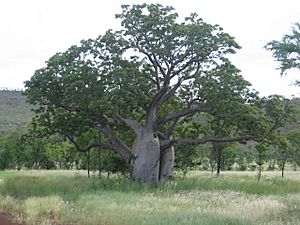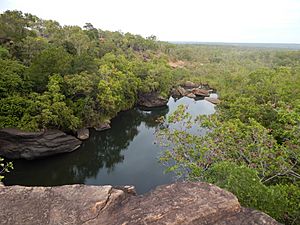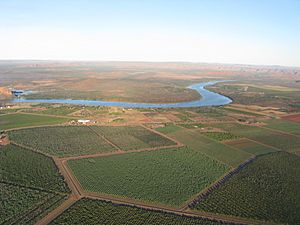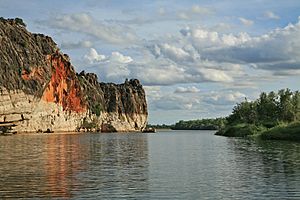Kimberley tropical savanna facts for kids
Quick facts for kids Kimberley tropical savanna |
|
|---|---|

Keep River National Park, Northern Territory
|
|
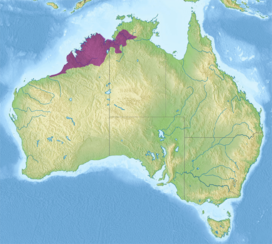
Ecoregion territory (in purple)
|
|
| Ecology | |
| Realm | Australasian |
| Biome | tropical and subtropical grasslands, savannas, and shrublands |
| Borders | Arnhem Land tropical savanna, Carpentaria tropical savanna, Great Sandy-Tanami desert, and Victoria Plains tropical savanna |
| Geography | |
| Area | 335,299 km2 (129,460 sq mi) |
| Country | Australia |
| States | Northern Territory and Western Australia |
| Conservation | |
| Conservation status | Vulnerable |
| Protected | 84,546 km² (25%) |
The Kimberley tropical savanna is a special natural area in northwestern Australia. It's a type of ecoregion where you find lots of tropical and subtropical grasslands, savannas, and shrublands. This area covers parts of Western Australia and the Northern Territory, stretching south from the Timor Sea.
Contents
Geography of the Kimberley Savanna
This amazing ecoregion is located along the coast of Northwestern Australia. It includes the Kimberley Region in Western Australia. It also reaches into the Northern Territory.
To the north, it meets the Timor Sea. Other natural areas border it, like the Arnhem Land tropical savanna to the northeast. The Carpentaria tropical savanna is to the east. The Victoria Plains tropical savanna is to the southeast and south. Finally, the Great Sandy-Tanami desert is to the southeast.
Much of this ecoregion has rough, rocky land. It is made of very old sandstone. The northern Kimberley coast is often steep with many small islands nearby.
Many rivers flow through this area. These include the Fitzroy, May, Drysdale, Durack, Ord, Victoria, and Daly rivers. These rivers often follow cracks in the sandstone. This has carved out amazing, deep gorges.
Some coastal areas in the Northern Kimberley are made of volcanic rock called basalt. The Mitchell Plateau and Bougainville Peninsula have a hard, rocky layer on top. This layer is called bauxite.
The southern Dampierland region has red sand deposits. This area includes the Dampier Peninsula and the coastal plain. The land here is mostly flat, with sand dunes and lagoons along the coast.
Special Regions in the Kimberley
The Kimberley tropical savanna includes five special areas. These are called IBRA regions. They are the Central Kimberley, Daly Basin, Dampierland, Northern Kimberley, and Victoria Bonaparte. Each of these areas has its own unique features.
Climate of the Kimberley Savanna
The ecoregion has a tropical savanna climate. This means it's hot all year round. The average high temperatures are usually between 25º and 35º C.
Rainfall happens mostly in the summer. This is during the monsoon season, from October to March. The rest of the year is a long dry season. The northern coastal areas get the most rain. Areas further south and inland get less. For example, the Mitchell Plateau gets about 1,400 mm of rain each year. But Broome in the southwest gets only about 600 mm.
Plants of the Kimberley Savanna
The land is mostly covered by savanna and open woodlands. The types of plants change depending on how much rain there is. They also depend on the soil and how often fires happen. You can also find wetlands and small patches of monsoon rainforest.
Woodlands and Savannas
You'll see many bloodwood eucalypts (Corymbia species) growing on sandy and loamy soils. The Boab (Adansonia gregorii) is a very special tree here. It loves sandy soils and stands out in the woodlands.
Where the soil is richer and there's more rain, you'll find Darwin stringybark (Eucalyptus tetrodonta) and Darwin woollybutt (E. miniata). These trees stay green all year. They form an open canopy, about 5 to 15 meters tall. Below them, there's tall grass. Common grasses include Sorghum, Heteropogon, Themeda, Chrysopogon, Aristida, and Eriachne. In some parts of Northern Kimberly, a palm tree called Livistona eastonii grows thickly under the taller trees.
River valleys have fine clay soils. Here, you'll find open woodlands with Terminalia and Bauhinia trees. The grasslands have Chrysopogon, Aristida, and Dichanthium grasses. In wetter spots, you'll see Xerochloa species. Many of these woodlands and grasslands have been turned into farms.
Pindan Woodlands
Pindan is a unique type of plant community. It grows on the Dampier Peninsula and in other southwestern parts of the ecoregion. You usually find it on red sandy soils. Pindan is an open woodland with shorter trees, about 3 to 8 meters tall. The main trees are wattles, like Acacia eriopoda, A. tumida, A. platycarpa, and A. colei. Sometimes, bloodwood trees grow taller than the wattle canopy.
Monsoon Rainforests
Small patches of monsoon rainforest are scattered around. They are usually within 150 km of the coast. There are about 1500 of these rainforest patches. Together, they cover about 7,000 hectares. Most patches are small, less than four hectares. Only a few are larger than 20 hectares, and the biggest is 200 hectares.
Monsoon rainforests have trees that lose their leaves in the dry season. This helps them save water. Woody vines are common and climb high into the trees. Shorter monsoon rainforests are also called monsoon vine thickets. The plants in the understory include small trees, shrubs, and vines.
These rainforests don't like fires, unlike the surrounding savannas. The savanna plants are used to frequent fires. Many trees and shrubs in the rainforests have juicy fruits. Birds, bats, and other animals eat these fruits and help spread the seeds.
You can find monsoon rainforests in many places. They grow behind coastal sand dunes, on hillsides, and at the edges of swamps and rivers. They also grow in gorges and gullies. The plants in these rainforests are different from those in the savannas. Many are very old plants from a supercontinent called Gondwana. Others are typical of the Australasian and Indomalayan tropics.
In Northern Kimberley, monsoon rainforests are common on rocky slopes. They are also found at the edges of freshwater swamps and mangrove areas. They grow best on volcanic slopes at the foot of the Mitchell Plateau and Bougainville Peninsula. Here, evergreen and deciduous trees form a canopy 15–20 meters tall. Some trees grow even taller.
Some trees in the Northern Kimberley monsoon rainforests include Aglaia elaeagnoidea, Albizia lebbeck, Brachychiton diversifolius, Bombax ceiba, Dysoxylum latifolium, Ficus species, and Terminalia ferdinandiana. Woody vines are very common. They climb all over the tree canopies. Small trees and shrubs grow underneath. These include Alectryon kimberleyanus and Murraya paniculata. Trees found at the edges of these rainforest patches include Acacia holoserica, boab (Adansonia gregorii), and helicopter tree (Gyrocarpus americanus).
The monsoon vine forests on the northern Dampier Peninsula can grow up to 12 meters tall. Common trees include Terminalia petiolaris and banyan fig (Ficus virens var. virens). Wild apple (Syzygium eucalyptoides subsp. bleeseri) also grows here. Gubinge (Terminalia ferdinandiana) grows on the edges closer to the land.
Coastal monsoon vine thickets stretch south from the Dampier Peninsula to Broome. They grow in areas that get at least 600 mm of rain each year. These thickets are small and often grow in lines along the sheltered side of sand dunes. They get water from a shallow underground source. The unique Cable Beach bloodwood (Corymbia paractia) is a special tree here. Other trees include Goonj (Celtis philippensis), broad-leaved ballart (Exocarpos latifolius), and mamajen (Mimusops elengi). Vines like Capparis lasiantha and stinking passionflower (Passiflora foetida) are also found here. These vine thickets often blend into pindan woodlands further inland.
Riparian Forests
Riparian forests are special forests that grow along rivers and streams. Common trees here include river red gum (Eucalyptus camaldulensis), Terminalia platyphylla, and Melaleuca leucadendra. You'll also find different types of Ficus trees.
Understory shrubs include Pandanus aquaticus and P. spiralis. Vines are not as common as in monsoon rainforests. However, the non-native stinking passionflower is very common in some areas. These riparian forests have many rainforest trees and shrubs that produce juicy fruits. These fruits are an important food source for many animals. The forests also provide homes and shelter for wildlife.
Animals of the Kimberley Savanna
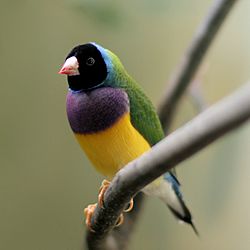
The Kimberley tropical savanna is home to many unique animals and plants. About 230 plant species are found only here. There are also six mammal species, two bird species, 31 reptile species, and 16 fish species that live nowhere else in the world!
Native mammals include the agile wallaby (Macropus agilis) and the common wallaroo (Osphranter robustus). You might also see the antilopine kangaroo (Osphranter antilopinus) and the northern quoll (Dasyurus hallucatus). Other animals include the bilby (Macrotis lagotis), short-beaked echidna (Tachyglossus aculeatus), and the sugar glider (Petaurus breviceps).
The golden bandicoot (Isoodon auratus) and golden-backed tree-rat (Mesembriomys macrurus) used to live all over this area. Now, they are only found in Northern Kimberley. Sadly, the boodie or burrowing bettong (Bettongia lesueur), a type of kangaroo, is now gone from this ecoregion.
The six mammals found only here are the Ningbing false antechinus (Pseudantechinus ningbing), scaly-tailed possum (Wyulda squamicaudata), monjon (Petrogale burbidgei), yellow-lipped bat (Vespadelus douglasorum), Kimberley mouse (Pseudomys laborifex), and Kimberley rock rat (Zyzomys woodwardi). Places like Windjana Gorge, Tunnel Creek, and Geikie Gorge have huge cave systems. These caves are home to very large groups of bats.
Two bird species are found only in this ecoregion. They are the black grasswren (Amytornis housei) and the white-quilled rock pigeon (Petrophassa albipennis). The black grasswren lives in the grassy sandstone hills of Northern Kimberley. The ecoregion is also home to the Gouldian finch (Erythrura gouldiae), which is a beautiful bird that is almost threatened. The purple-crowned fairywren (Malurus coronatus) is also in danger. Its home along the Ord and Fitzroy rivers has been damaged by cattle and farming.
The wetlands in this ecoregion are very important for water birds. Many birds, both migratory and resident, live here. The Glossy ibis (Plegadis falcinellus) and magpie goose (Anseranas semipalmata) are the most common. The Ord River Floodplain, Parry Creek floodplain, Eighty Mile Beach, and Roebuck Bay are special wetlands. Lakes Argyle and Kununurra are man-made lakes on the Ord River. They have become important safe places for birds during the dry season. The rocky northern coast and nearby islands are where herons, cormorants, and other seabirds raise their young.
The ecoregion has many unique reptiles. These include seven species of geckoes and four agamid lizards. There are also 13 types of skinks. Unique snakes include the rough-scaled python (Morelia carinata) and several types of blind snakes.
The frogs found only here include the flat-headed frog (Limnodynastes depressus) and the cave-dwelling frog (Ranoidea cavernicola). You can also find the magnificent tree frog (Ranoidea splendida) and several types of toadlets.
Protecting the Kimberley Savanna
The wildlife in the Kimberley ecoregion faces some challenges. Their homes are being lost as land is turned into farms and pastures. Too many cattle, donkeys, pigs, and rabbits are eating and trampling the plants.
Changes in how fires are managed also cause problems. Aboriginal people used to set small, frequent fires. This kept the land healthy. Now, fires are often stopped, leading to bigger, more damaging fires later in the dry season. Also, new animals like house cats and foxes have been brought in. They hunt native animals.
Many introduced plants have become widespread weeds. They push out native plants and change the natural fire and water cycles. They also affect food sources for native animals. Some of these problem plants include rough cocklebur (Xanthium strumarium) and stinking passionflower (Passiflora foetida).
Protected Areas
A study in 2017 showed that about 25% of the ecoregion is protected. This is about 84,546 square kilometers. These protected areas help keep the plants and animals safe.
Some of the protected areas include Drysdale River National Park, Keep River National Park, and Mitchell River National Park. Other important parks are Prince Regent National Park, Danggu Gorge National Park, and Mirima National Park. There are also wildlife sanctuaries like Charnley River–Artesian Range Sanctuary.
Many Indigenous Protected Areas (IPAs) are also in this ecoregion. These are managed by Aboriginal peoples. They include Nyangumarta Warrarn Indigenous Protected Area, Yawuru Indigenous Protected Area, Bardi Jawi Indigenous Protected Area, Dambimangari Indigenous Protected Area, Karajarri Indigenous Protected Area, Uunguu Indigenous Protected Area, Wilinggin Indigenous Protected Area, Balanggarra Indigenous Protected Area, and Wardaman Indigenous Protected Area. These areas are very important for protecting the land and its culture.


